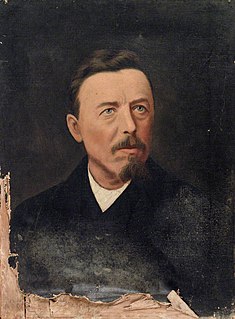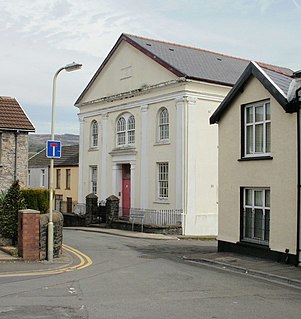
Carmarthen is the county town of Carmarthenshire and a community in Wales, lying on the River Towy. 8 miles (13 km) north of its estuary in Carmarthen Bay. The population was 14,185 in 2011, down from 15,854 in 2001, but gauged at 16,285 in 2019. It has a claim to be the oldest town in Wales – Old Carmarthen and New Carmarthen became one borough in 1546. It was the most populous borough in Wales in the 16th–18th centuries, described by William Camden as "chief citie of the country". Growth stagnated by the mid-19th century as new settlements developed in the South Wales Coalfield.

The Baptist Union of Wales is a fellowship of Baptist churches in Wales.

Ammanford is a town and community in Carmarthenshire, Wales, with a population of 5,411 at the 2011 census. It is a former coal mining town. The built-up area had a population of 7,945 with the wider urban area even bigger.

William Nantlais Williams, better known simply as Nantlais, was a Welsh poet and a Presbyterian Christian minister who played a prominent role in the 1904-1905 Welsh Revival.

Watkin Hezekiah Williams (1844–1905), known as Watcyn Wyn, was a Welsh schoolmaster and poet.

Calfaria Baptist Chapel, Aberdare, was one of the largest baptist churches in the South Wales Valleys and the oldest in the Aberdare valley. The chapel had an ornate interior, including a boarded ceiling with a deeply undercut rose, while the balcony balustrading had a cast iron front with an intricate foliage design. These features were common in the Welsh chapels of the late nineteenth century. The organ was installed in 1903 at a cost of £850. It was played for the last time in 2012 by Robert Nicholls, during a Radio Cymru broadcast shortly before the closure of the chapel.

Joshua Thomas (1719–1797) was a Welsh writer and Particular Baptist minister, known for his history of Welsh Baptists.

Bethel, Abernant is a Baptist Chapel at Abernant in the Aberdare Valley in Wales and one of the few nonconformist chapels in the area that remained open into the twenty-first century.
Heolyfelin Chapel, Trecynon, Aberdare was a Welsh Baptist chapel established in 1855. Services were held in the Welsh language. The building seated 800. By December 2015 the chapel had closed and was for sale.
Gwawr, Aberaman was a Baptist chapel in Regent Street, Aberaman, near Aberdare, South Wales, formed as a branch of Calfaria, Aberdare
Seion, Cwmaman is a Welsh Baptist church, originally established in 1859. The chapel closed in 2013 but the church still meets at another location in the village.

Llandissilio is a village and parish in the community of Llandissilio West in east Pembrokeshire, Wales on the A478 road between Efailwen to the north and Clunderwen to the south. A largely ribbon development along the main road, the village is surrounded by farmland.

Gadlys Chapel was a Baptist chapel in Railway Street, Gadlys, Aberdare, Rhondda Cynon Taf, Wales. It was formed as a branch of Calfaria, Aberdare.

Thomas Thomas was a Welsh church minister and chapel architect, also known as Thomas Glandŵr. He is described as "the first national architect of Wales" and the "unchallenged master of chapel architecture in Wales in the 1860s".

Bethesda, Abercwmboi is a Welsh Baptist church in Abercwmboi near Aberdare. Services continue to be held in the Welsh language.
Bethania, Cwmbach was a Baptist Chapel at Cwmbach in the Aberdare Valley in Wales. Badly damaged by an air raid attack in 1941 it was subsequently restored but closed in the 1980s. Services were held in the Welsh language.
Rhos, Mountain Ash was a Baptist chapel in Mountain Ash, Glamorgan, Wales. Services at Rhos were conducted in the Welsh language.
Soar, Llwydcoed was a Baptist Chapel in Kingsbury Place, Llwydcoed, Aberdare, Glamorgan, Wales. Services at Soar were held in the Welsh language.
Saron is a Baptist chapel in the village of Saron in the community of Llandybie, Ammanford, Carmarthenshire. Services at Saron are conducted in the Welsh language.
Calfaria is a Baptist chapel in the village of Penygroes in the community of Llandybie, near Ammanford, Carmarthenshire. Services at Calfaria were conducted in the Welsh language until recently but are now bilingual.












